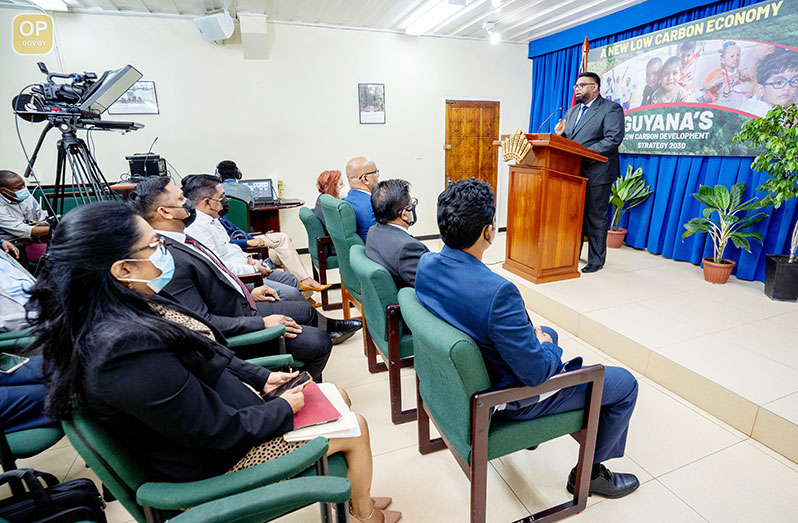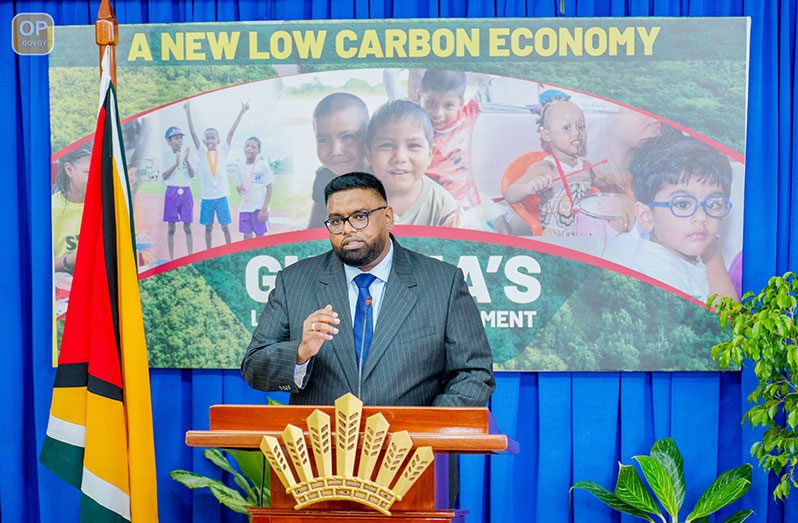— President Ali opens LCDS 2030 for public consultation
EVEN with a burgeoning oil and gas economy, Guyana is still working to maintain its stance as a global powerhouse in the fight against climate change. In doing so, the Dr. Irfaan Ali-led government has crafted a revised Low Carbon Development Strategy (LCDS) 2030, which was released on Thursday for public consultation.
The original LCDS was pioneered in 2009 by then President and current Vice-President, Dr. Bharrat Jagdeo, and has now been altered in keeping with Guyana’s current status as a petroleum producer. “So, the context of the LCDS we launch today – LCDS 2030 – is very different to the context of 2009…we intend to remain one of the world’s lowest carbon economies – prioritising action on forests and energy,” Dr. Ali noted.
He assured that Guyana intends to pursue strong policies to ensure that its oil and gas sector operates to international standards. More notably, President Ali said that government is working to eliminate flaring from oil production, except in the case of genuine emergencies.

“When my government took office in 2020, there were no safeguards in place to disallow flaring. As a result, we introduced one of the very few taxes on flaring in the world – where beyond the commissioning period, all flaring will be taxed at US$45 per tonne of carbon, along with the actual gas lost,” Dr. Ali said, adding, “For newly-licensed production, the tax on flaring will be accompanied by legal limits on the overall amount of flaring.”
Similarly, he said that new measures have also been introduced to ensure that all waste management is the responsibility of the oil producer, in accordance with international standards, from “cradle to grave”.
Added to that, the Head of State said that Guyana will also be working with oil producers to explore and promote use of lower carbon technological innovation, including the use of renewable energy in oil production, Carbon Capture Utilisation and Storage (CCUS) and, when technologically viable, green hydrogen.
The Head of State was keen to note that the People’s Progressive Party/ Civic (PPP/C) Government will work to meet its responsibilities to the people of Guyana by maximising the benefits to be accrued from the oil and gas industry, whilst advocating for global policies to create a level playing field that align the global marketplace for oil and gas, with the goals of the Paris Climate Agreement.
In highlighting some of the disparities that exist, President Ali pointed to the fact that the United States of America, the world’s largest oil producer, has a per capita income of US$65,000, which is 10 times that of Guyana.
He said, pointedly, that no responsible government should volunteer that its people stay poor so that richer countries can have their market protected. To this end, Dr. Ali insisted that there should be a global price on carbon, levied on the consumption of oil and gas. He believes too that subsidy for fossil fuel production should be removed.
“In 2019, fifty of the largest economies in the world, which account for 80 per cent of global greenhouse gas emission, increased their support for fossil fuel production by 30 per cent. Most of this was in developed countries, which are already the incumbents benefitting most from the trillions of dollars in the oil and gas market,” Dr. Ali indicated. Once a level playing field is created, President Ali affirmed that Guyana will not shirk its responsibilities in such a marketplace.
ALTERNATIVE ENERGY
Also critical to the balance between economy and environment is the need for Guyana to transition from an energy sector that is 97 per cent dependent on fossil fuel, into one that is able to utilise an energy mix utilising Guyana’s renewable resources such as wind, hydro and solar.
An iconic aspect of the 2009 LCDS had to do with the Amaila Falls Hydropower Project which was ‘tanked’ by the former A Partnership for National Unity + Alliance For Change (APNU+AFC) Government. “All the technical analysis over the years, including a report presented by a consultancy engaged by the last Government and Norway, concluded that Amaila Falls Hydropower project represented the best way forward to expand Guyana’s energy supply,” Dr. Ali reminded.
With the PPP/C Government now back in place, the Amaila Falls Project is back on stream, and is now part of a more detailed energy mix.
“This energy transition will achieve a level that very few, if any, countries have achieved. Cheaper electricity will be supplied, and that supply can increase fivefold with emissions staying essentially flat,” the President shared. He said that the energy transition will form the backbone of the broader low carbon transition outlined in the LCDS 2030.
BILLIONS FROM THE FOREST
A significant component of the LCDS, both the 2009 and the 2030 editions, has to do with Guyana’s forest, and how it can be used as a major income earner for the country. “If oil and gas is a bedrock of today’s global economy, the world’s ecosystems need to be the bedrock of the future economy… Guyana became one of the first countries in the world to recognise this,” Dr. Ali posited.
He reminded that in 2009, when Guyana set out the original LCDS, Guyana made a landmark offer to “create a global model for jurisdiction-scale action to show how the world’s forests could be maintained”.
To put it simply, the LCDS paved the way for countries with high carbon emissions to pay countries like Guyana to maintain its forest. The President noted that for the period 2009 to 2015, Guyana earned US$212 million in payments to be invested in the LCDS.
“Guyana alone stores about 19.5 billion tonnes of carbon in our forests,” Dr. Ali added.
He said that “Because of the work of the last twelve years, we now know that Guyana has maintained the second highest percentage of forest cover on earth – with more than 99.5 per cent of our forest remaining – an area almost the size of England and Scotland combined.”
Dr. Ali noted that Guyana’s ecosystems have enormous value to the global economy. “We have four percent of known animal species. There are more bird species in Guyana than in the entire United States of America. We have 2.4 per cent of known plant species,” Dr. Ali said.
He specified that Guyana’s forests alone have an estimated value of up to US$54 billion annually. However, President Ali lamented that, unlike oil and gas, the world does not yet recognise the value of its forest in monetary terms. “This is the main reason that forests across the world are cleared for agriculture, mining, infrastructure, and other uses,” Dr. Ali noted.
The Head of State assured that via the LCDS 2030, Guyana will capitalise on its position as a carbon sink, to develop the lives of all Guyanese.
“There are a number of possibilities outlined in the LCDS 2030, but I want to emphasise that no agreements will be entered into until after the national consultation is completed and the LCDS 2030 is finalised,” President Ali assured.
He said that the document, which is currently in its draft stages, will only be finalised once all those involved have agreed to its contents. More importantly, Dr. Ali said that particular emphasis will be placed on adhering to a set of United Nations-mandated safeguards, including the principle known as ‘Free Prior and Informed Consent’ (FPIC), which ensures that indigenous peoples and communities have a direct say in the policies and programmes that affect them and their livelihoods.
“A dedicated 15 per cent of funds from forest climate services will be invested in Amerindian communities’ priorities, including land titling and capitalisation of the Amerindian Development Fund to implement Community Development Plans. Low carbon infrastructure will be expanded – including transportation, digital infrastructure, e-Governance, and social inclusion. The urban-built environment – roads, drainage and water infrastructure among other areas – will be improved in all our towns,” Dr. Ali promised.
Nonetheless, he said that to carry out the national consultation, the Multi-Stakeholder Steering Committee will be reconstituted. In encouraging input into the document, President Ali said that Guyana is at a point where it is full of promise and potential, and that once Guyanese come together and seize the opportunities that exist, the country is poised to become a global powerhouse.
“We can provide answers to some of the biggest questions the world faces, like balancing energy and climate security or creating the basis for a future ecosystem services economy. We can help our people to become prosperous without leaving anybody behind,” President Ali said.




.jpg)










